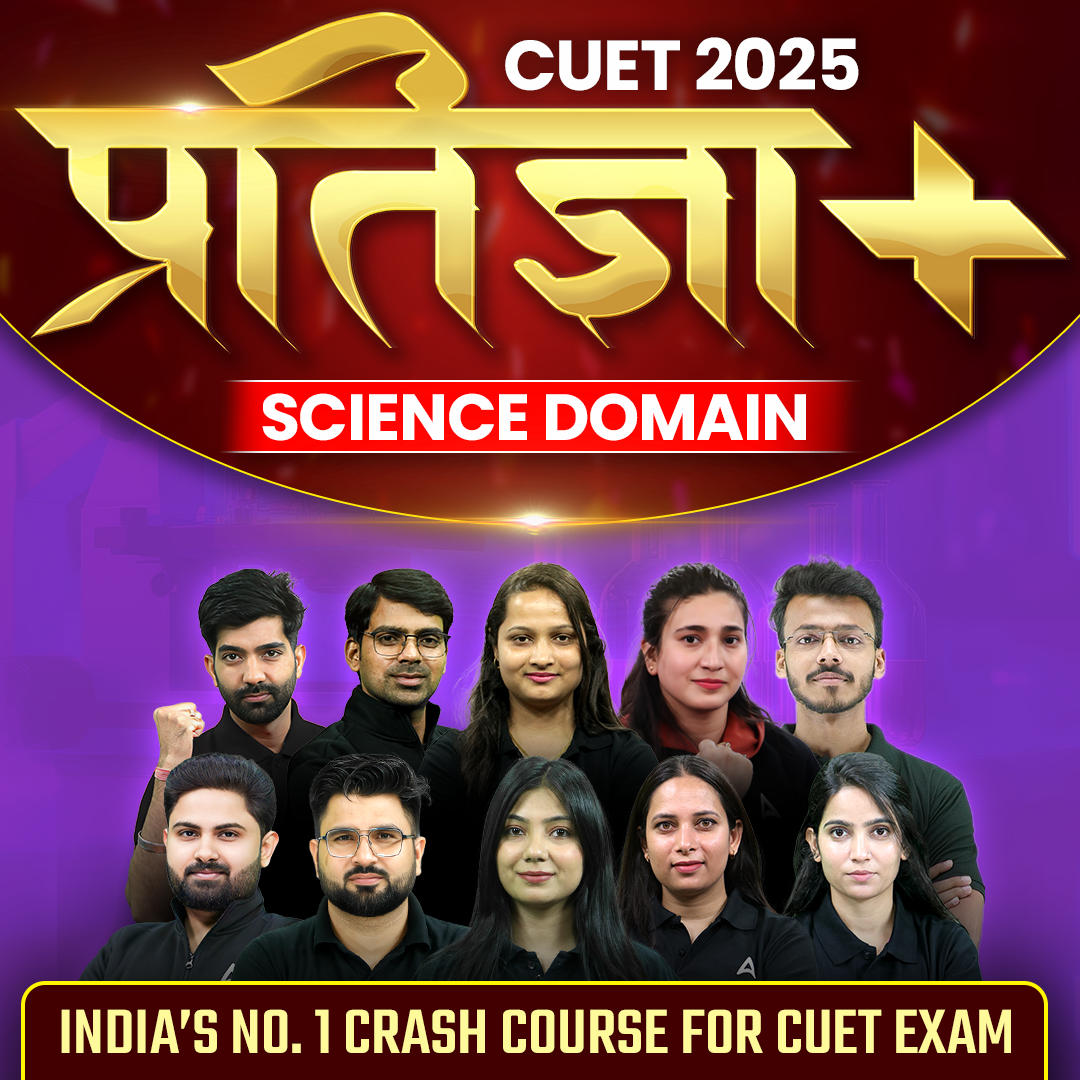Table of Contents
To crack the behemoth exams like CUET UG, you will not only require the best guidance but also a well structured curated practice resource that will help you sail through the exam. Biology being a subject highly inclined towards theory, students need to practice only relevant topics for CUET from the sea of online resources available. To keep students on the right, our CUET team has prepared the top questions to look out for in the CUET UG biology paper.
CUET Biology Important 100 Questions with Answers
The highly acclaimed CUET UG expert faculty at Adda247 has prepared the list of top 100 questions that are important for the CUET Biology exam paper. These questions have been compiled after a thorough analysis of the past years papers. The questions featuring in this list is based on the updated syllabus and exam pattern.
Along with the questions, our experts have also given the solutions for the questions. The solutions will help students understand the correct logic behind every question. But we encourage students to answer the questions first without looking at the answers. This will help them in grasping concepts more easily.
CUET Biology Important 100 Questions and Answers
Take a look at the top 100 important biology questions with answers for the CUET UG exam.
Q1. Terror of Bengal’ is another name of:
(a) Solanum tuberosum
(b) Eichhornia crassipes
(c) Algal bloom
(d) Oryza sativa
Q2. Which of the following plant flowers once in 12 years?
(a) Ficus benghalensis
(b) Strobilanthus kunthiana
(c) Mangiferra indica
(d) Tectona grandis
Q3. Oestrus cycle is observed in
(a) Cow
(b) Deer
(c) Tiger
(d) All of the above
Q4. The fruits that develop without fertilization are called as
(a) True fruits
(b) False fruits
(c) Parthenocarpic fruits
(d) Hybrid fruit
Q5. Which of the following statement about triple fusion is correct?
(a) It is the fusion of one male gamete and two polar nuclei
(b) It is the fusion of two male gametes and one polar nuclei
(c) It is the fusion of one male gamete and three polar nuclei
(d) It is the fusion of three male gametes and one polar nuclei
Q6. Which of the following devices prevent autogamy in plants?
(a) Positioning of anther and stigma at different positions
(b) Unisexual flowers
(c) Self-incompatibility
(d) All
Q7. Oogenesis is initiated during the embryonic development stage, the cells start division and enter into which phase and get temporarily arrested?
(a) Metaphase I
(b) Telophase I
(c) Prophase I
(d) Anaphase I
Q8. The layer of the uterus that undergoes cyclical changes during menstrual cycle is
(a) Perimetrium
(b) Myometrium
(c) Pleura
(d) Endometrium
Q9. Which of the following hormone is secreted by the ovary in the later phase of pregnancy?
(a) Lactogen
(b) Relaxin
(c) Human chorionic gonadotropin (hCG)
(d) Estrogen
Q10. After spermiogenesis is complete, in which of the following the sperm heads become embedded and get released finally from the Seminiferous tubules?
(a) Interstitial cells
(b) Leydig cells
(c) Sertoli cells
(d) All of the above
Q11. Oral pills contain
(a) Progestogen–estrogen
(b) Progestogen–oxytocin
(c) Relaxin–estrogen
(d) Vasopressin–estrogen
Q12. Which of the following is a non-medicated IUD?
(a) LNG-20 (b) Lippes loop
(c) Multiload 375 (d) None of the above
Q13. Which of the following is a sex-linked recessive disorder?
(a) Down’s syndrome (b) Colour blindness
(c) Klinefelter’s syndrome (d) Turner’s syndrome
Q14. Incomplete dominance can be observed in __________
(a) Azadirachta indica
(b) Antirrhinum majus
(c) Ocimum tenuiflorum
(d) None of the above
Q15. The probability of having a haemophilia carrier daughter by a haemophilia carrier mother and a normal father is:
(a) 100%
(b) 50%
(c) 25%
(d) 75%
Q16. Which of the following is called adaptor molecule?
(a) DNA
(b) m-RNA
(c) t-RNA
(d) RNA
Q17. Which of the following gene codes for permease in the lac operon that increases the permeability of the cell to beta galactosidase?
(a) Gene i (b) Gene y
(c) Gene a (d) All of the above
Q18. Identify the flow of information according to the “Central Dogma” of Molecular biology:
(a) mRNA->Protein->DNA
(b) mRNA->tRNA->RNA
(c) DNA->mRNA->Protein
(d) Protein->mRNA->DNA
Q19. A person with any one blood group among the following is a universal donor
(a) AB
(b) A
(c) B
(d) O
Q20. Oparin and Haldane’s theory of chemical evolution of life was experimentally supported by:
(a) Landsteiner and Weiner
(b) Hardy and Weinberg
(c) Oparin and Sydney Fox
(d) Miller and Urey
Q21. What was the brain capacity of Neanderthal Man?
(a) 650 cc
(b) 800 cc
(c) 900 cc
(d) 1400 cc
Q22. Which of the following is / are examples of analogy?
(a) Eye of the octopus and of mammals
(b) Flippers of Penguins and Dolphins
(c) Sweet potato and potato
(d) All of the above
Q23. Select the correct option for ‘1’, ‘2’, ‘3’, ‘4’ mentioned in the boxes.

(a) 1 → convergent, 2→ homologous, 3→ divergent, 4→ analogous
(b) 1→analogous, 2→ homologous, 3→ divergent, 4→ convergent
(c) 1→ homologous, 2→ convergent, 3→ analogous, 4→ divergent
(d) 1→ homologous, 2→ divergent evolution, 3→ analogous, 4→convergent
Q24. The ring worm is one of the most common infectious disease caused by:
(a) Virus
(b) Bacteria
(c) Fungi
(d) Yeast
Q25. Which of the following disease is caused by Haemophilus influenza?
(a) Malaria
(b) Dysentry
(c) Pneumonia
(d) Filariasis
Q26. Which of the following is/are wheat varieties?
(a) Sonalika
(b) Kalyan sona
(c) Saccharum barberi
(d) Both (a) and (b)
Q27. Which sugarcane species was originally grown in North India?
(a) Saccharum officinarum
(b) Saccharum barberi
(c) Aegilops speltoides
(d) Aegilops squarrosa
Q28. Naked protoplast are devoid of
(a) Cell membrane
(b) Cell wall
(c) Plasma membrane
(d) All of the above
Q29. Which of the following types of breeding allows the desirable qualities of two different breeds to be combined?
(a) Outcrossing
(b) Inbreeding
(c) Cross-breeding
(d) All of the above
Q30. Use of biofertilizers as a nutrient source is a practised in ________________.
(a) Inorganic farming
(b) Animal husbandry
(c) Organic farming
(d) Crop rotation
Q31. Which of the following is used as an immunosuppressive agent in organ-transplant patients?
(a) Cyclosporin A
(b) Statins
(c) Hexokinase
(d) Lipase
Q32. The technology of biogas production was developed in India mainly due to the efforts of
(a) NBPGR
(b) IARI
(c) KVIC
(d) Both (b) and (c)
Q33. Which of the following bacteria is used for making Swiss cheese?
(a) LAB
(b) Propionibacterium sharmanii
(c) Acetobactor aceti
(d) Clostridium butylicum
Q34. Which of the following enzyme always cut DNA molecules at a particular point by recognising a specific sequence of 6 base pairs?
(a) Bam H 1 (b) Eco R 1
(c) Hind II (d) Hind III
Q35. The enzyme which is used to remove nucleotides from the ends of DNA fragment is-
(a) DNA ligase
(b) Restriction endonuclease
(c) Restriction exonuclease
(d) DNA Polymerase
Q36. In which of the following method recombinant DNA is directly injected into the nucleus of an animal cell?
(a) Biolistics
(b) Gene gun
(c) Microinjection
(d) All of the above
Q37. For which of the following disease, the transgenic animal model has not been developed?
(a) Cancer
(b) Cystic Fibrosis
(c) AIDS
(d) Alzheimer’s disease
Q38. Which of the following genes control cotton boll worms?
(a) cryIAc (b) cryIIAb
(c) cryIAb (d) Both (a) and (b
Q39. The graph of a population showing exponential on geometric growth pattern is.
(a) S-shaped (b) J-shaped
(c) U-shaped (d) All of the above
Q40. The number of alive individuals between 1st year to 2nd year of a life table is 1000. During this interval 400 individuals die, then what is the death rate for this interval?
(a) 0.4
(b) 0.04
(c) 0.004
(d) 0.0004
Q41. The secondary ecological succession begins in an area, where:
(a) Species invade a bare land/rock
(b) Vegetation has been grazed by Cattles
(c) Natural biotic communities have been destroyed
(d) Natural biotic communities are flourishing
Q42. In a particular climatic condition, decomposition rate is slower if
(a) Detritus is rich in nitrogen
(b) Detritus is rich in sugar
(c) Detritus is rich in water-soluble substances
(d) Detritus is rich in lignin and chitin
Q43. The flow of materials from non living components to living components and back to the non living components in a more or less cyclic manner is called
(a) Gaseous cycle
(b) Sedimentary cycle
(c) Biogeochemical cycle
(d) Hydrologic cycle
Q44. Species -area relationship in South American jungles was studied by –
(a) Alexander von Humboldt
(b) Paul Ehrlich
(c) Robert May
(d) David Tilman
Q45. Which of the following are a part of ex-situ conservation?
(a) Zoological park (b) Botanical Garden
(c) Wildlife safari park (d) All of the above
Q46. Which of the following is NOT a narrowly utilitarian arguments for conserving biodiversity?
(a) Food
(b) Pollination
(c) Industrial products
(d) products of medicinal importance
Q47. According to Central Pollution Control Board (CPCB), which particulate size in diameter (in micrometers) of the air pollutants is responsible for greatest harm to human health?
(a) 1.0 or less
(b) 5.2 – 2.5
(c) 2.5 or less
(d) 1.5 or less
Q48. An incorrect statement about the catalytic converter among the following is.
(a) Platinum-palladium and rhodium are catalyst
(b) Lead in petrol activates the catalyst
(c) Reduced the emission of poisonous gases
(d) CO and NOX changed to CO2 and N2
Q49. Which of the following is not a greenhouse gas?
(a) CO2
(b) CH4
(c) H2S
(d) N2O
Direction: in the following questions, a statement of assertion (A) is followed by a statement of reason (R). Choose the correct option among a, b, c and d.
Q50. Assertion (A): The unequivocal proof that DNA is the genetic material came from the experiments of Alfred Hershey and Martha Chase.
Reason (R): They worked on Streptococcus pneumonia.
(a) Both assertion (A) and reason (R) are true and reason (R) is the correct explanation of assertion (A)
(b) Both assertion (A) and reason (R) are true but reason (R) is not the correct explanation of assertion (A)
(c) Assertion (A) is true but reason(R) is false
(d) Assertion (A) is false but reason(R) is true
Q51. Assertion (A): Dysentery, plague, diphtheria, etc., are some of the other bacterial diseases in man.
Reason (R): Rhino viruses are a group of viruses which cause one of the most infectious human ailments – the common cold.
(a) Both assertion (A) and reason (R) are true and reason (R) is the correct explanation of assertion (A)
(b) Both assertion (A) and reason (R) are true but reason (R) is not the correct explanation of assertion (A)
(c) Assertion (A) is true but reason(R) is false
(d) Assertion (A) is false but reason(R) is true
Q52. Assertion (A): In a chromosome there is a specific DNA sequence called the origin of replication, which is responsible for initiating replication.
Reason (R): The construction of the first recombinant DNA emerged from the possibility of linking a gene encoding antibiotic resistance with a native plasmid of Salmonella typhimurium.
(a) Both assertion (A) and reason (R) are true and reason (R) is the correct explanation of assertion (A)
(b) Both assertion (A) and reason (R) are true but reason (R) is not the correct explanation of assertion (A)
(c) Assertion (A) is true but reason(R) is false
(d) Assertion (A) is false but reason(R) is true
Q53. Assertion (A): MOET is a programme for herd improvement
Reason (R): In this method, a cow is administered hormones, with ACTH-like activity, to induce follicular maturation and super ovulation
(a) Both assertion (A) and reason (R) are true and reason (R) is the correct explanation of assertion (A)
(b) Both assertion (A) and reason (R) are true but reason (R) is not the correct explanation of assertion (A)
(c) Assertion (A) is true but reason(R) is false
(d) Assertion (A) is false but reason(R) is true
Q54. Assertion (A): Pyramid of biomass is always upright for tree ecosystem
Reason (R): Total biomass of a tree in a specific area is more than that of the herbivores.
(a) Both assertion (A) and reason (R) are true and reason (R) is the correct explanation of assertion (A)
(b) Both assertion (A) and reason (R) are true but reason (R) is not the correct explanation of assertion (A)
(c) Assertion (A) is true but reason(R) is false
(d) Assertion (A) is false but reason(R) is true
Q55. Assertion (A): When a species becomes extinct, the plant and animal species associated with it in an obligatory way also become extinct.
Reason (R): Steller’s sea cow and passenger pigeon is an example of co-extinction.
(a) Both assertion (A) and reason (R) are true and reason (R) is the correct explanation of assertion (A)
(b) Both assertion (A) and reason (R) are true but reason (R) is not the correct explanation of assertion (A)
(c) Assertion (A) is true but reason(R) is false
(d) Assertion (A) is false but reason(R) is true
Q56. Which of the following statement is correct?
(1) The offspring formed by sexual reproduction are identical and are called clones
(2) Ginger vegetatively propagates by offset
(3) Asexual reproduction is the common method of reproduction in organisms that have a relatively
simple organisation
(4) Gemmules are found in sponges
Choose the correct answer from the options given below:
(a) 1 and 3 only
(b) 3 and 4 only
(c) 1 and 4 only
(d) 1, 2 and 3
Q57. Arrange the given steps in correct sequence of their occurrence when lactose is provided in the growth medium of bacteria:
(1) Operator got free, RNA polymerase binds to promoter
(2) Lactose is hydrolysed to glucose and galactose
(3) Lactose binds to repressor protein
(4) Gene z, y, a are transcribed
Choose the correct answer from the options given below:
(a) (4), (2), (3), (1)
(b) (3), (1), (4), (2)
(c) (3), (2), (4), (1)
(d) (1), (2), (3), (4)
Q58. Which of the following statement is correct?
(1) The embryo with 8 to 16 blastomeres is called a morula
(2) The blastomeres in the blastocyst are arranged into an outer layer called inner cell mass and an inner group of cells called trophoblast
(3) The inner cell mass contains certain cells called stem cells which have the potency to give rise to all the tissues and organs
(4) The average duration of human pregnancy is about 19 months
Choose the correct answer from the options given below:
(a) (1) and (3)
(b) (2) and (3)
(c) (3) and (4)
(d) (1) and (4)
Q59. Which of the following statement is correct?
(1) In parthenocarpy fruits develop without fertilization
(2) Mango is a parthenocarpic fruit
(3) Parthenocarpy can be induced through the application of growth hormones
(4) Parthenocarpic fruits bear seeds
Choose the correct answer from the options given below:
(a) 1 and 4 only
(b)1, 2 and 4
(c) 3 and 4 only
(d) 1 and 3 only
Q60. Identify the statements which are true for DNA.
(A) It is a long polymer of ribonucleotides
(B) The backbone of a polynucleotide chain is formed due to sugar and phosphodiester bonds
(C) The two chains in DNA are coiled in a left-handed fashion
(D) The pitch of the helix is 3.4 nm
Choose the correct answer from the options given below:
(a) (A) and (D)
(b) (B) and (C)
(c) (B) and (D)
(d) Only (D)
Q61. Arrange the following steps of sewage treatment in correct sequence:
- Flocs consume organic matter and reduces the BOD.
- Removal of floating debris and grit.
- Bacterial flocs allowed to sediment.
- Primary effluent passed into aeration tank and agitated mechanically.
- Effluent after secondary treatment is released into water bodies.
Choose the correct answer from the options given below:
(a) B—D—A—C—E
(b) B—C—A—D—E
(c) A—D—E—B—C
(d) A—C—D—E—B
Q62. Which of the following statement are correct?
(1) In Ex situ Conservation approach, threatened animals and plants are taken out from their natural habitat and placed in special setting where they can be protected and given special care
(2) National parks and wildlife sanctuaries are off site conservation approach
(3) Now gametes of threatened species can be preserved in viable and fertile condition for long periods using cryopreservation techniques
(4) Technique of cryopreservation is an in-situ approach
Choose the correct answer from the options given below:
(a) (1) and (2)
(b) (2) and (3)
(c) (2) and (4)
(d) (1) and (3)
Q63. Arrange the following steps for replication of HIV in a correct sequence:
- Production of new viral RNA by infected cell
- Infection of normal cell by virus
- Production of viral DNA
- Production of new viruses
Choose the correct answer from the options given below:
(a) B, C, D, A
(b) A, B, C, D
(c) D, C, B, A
(d) B, C, A, D
Q64. Which of the following statement is correct?
(1) Microbes especially yeasts have been used from time immemorial for the production of beverages
(2) Lactobacillus is commonly called brewer’s yeast, is used for fermenting malted cereals and fruit juices, to produce ethanol.
(3) Wine and beer are produced by distillation of the fermented broth
(4) Antibiotics are chemical substances, which are produced by some microbes and can kill or retard the growth of other (disease-causing) microbes
Choose the correct answer from the options given below:
- (1) and (2)
- (2) and (4)
- (3) and (4)
- (1) and (4)
Q65. Which of the following statement is correct?
Statement I: Saheli was developed by the scientists of National Institute of Immunology.
Statement II: Saheli is a ‘once a week’ pill’.
In the light of above statements, choose the most appropiate answer from the options given below:
(a) Both statement I and II are correct
(b) Both statement I and II are incorrect
(c) Statement I is correct but statement II is incorrect
(d) Statement I is incorrect but statement II is correct
Q66. Given below are two statements:
Statement I: Embryological support for evolution was also proposed by Ernst Heckel.
Statement II: It was disapproved on careful study performed by Karl Ernst von Baer.
In the light of above statements, choose the most appropriate answer from the options given below:
(a) Both statement I and II are correct
(b) Both statement I and II are incorrect
(c) Statement I is correct and statement II is incorrect
(d) Statement I is incorrect and statement II correct
Q67. Given below are two statements:
Statement I: The size of a population for any species is a static parameter
Statement II: Immigration is the number of individuals of the population who left the habitat and gone elsewhere during the time period under consideration.
In the light of above statements, choose the most appropiate answer from the options given below:
(a) Both statement I and II are correct
(b) Both statement I and II are incorrect
(c) Statement I is correct and statement II is incorrect
(d) Statement I is incorrect and statement II correct
Q68. Given below are two statements:
Statement I: Gene therapy is a collection of methods that allows correction of a gene defect that has been diagnosed in a child/embryo.
Statement II: Here genes are inserted into a person’s cells and tissues to treat a disease.
In the light of above statements, choose the most appropriate answer from the options given below:
(a) Both statement I and II are correct
(b) Both statement I and II are incorrect
(c) Statement I is correct and statement II is incorrect
(d) Statement I is incorrect and statement II correct
Q69. Given below are two statements:
Statement I: LH surge induces rupture of Graafian follicle and thereby ovulation.
Statement II: During pregnancy all events of the menstrual cycle stop and there is no menstruation.
In the light of above statements, choose the most appropriate answer from the options given below:
(a) Both statement I and II are correct
(b) Both statement I and II are incorrect
(c) Statement I is correct and statement II is incorrect
(d) Statement I is incorrect and statement II correct
Q70. Given below are two statements:
Statement I: Down’s syndrome is caused due to trisomy of chromosome 21.
Statement II: Females which such a syndrome are sterile.
In the light of above statements, choose the most appropiate answer from the options given below:
(a) Both statement I and II are correct
(b) Both statement I and II are incorrect
(c) Statement I is correct and statement II is incorrect
(d) Statement I is incorrect and statement II correct
Q71. Match List-I with List-II:
| List-I | List-II | ||
| (A) | The triple nature of genetic code | (I) | George Gamow |
| (B) | The technique of DNA fingerprinting | (II) | Francis Crick |
| (C) | Lac operon | (III) | Alec Jeffreys |
| (D) | Central dogma | (IV) | Jacob and Monod |
Choose the correct answer from the options given below:
(a) (A)-(III), (B)-(II), (C)-(I), (D)-(IV)
(b) (A)-(IV), (B)-(II), (C)-(I), (D)-(III)
(c) (A)-(I), (B)-(III), (C)-(IV), (D)-(II)
(d) (A)-(II), (B)-(III), (C)-(IV), (D)-(I)
Q72. Match the following:
| List I | List II | ||
| (A) | Bryophyllum | (i) | Eyes |
| (B) | Agave | (ii) | Offset |
| (C) | Potato | (iii) | Leaf buds |
| (D) | Water hyacinth | (iv) | Bulbil |
(a) (A)→(ii); (B)→(iii); (C)→(iv); (D)→(i) (b) (A)→(iii); (B)→(iv); (C)→(i); (D)→(ii)
(c) (A)→(iv); (B)→(iii); (C)→(ii); (D)→(i) (d) (A)→(i); (B)→(ii); (C)→(iii); (D)→(iv)
Q73. Match the following:
| List I | List II | ||
| (A) | Copper-T | (I) | Semen contains no sperms |
| (B) | Vasectomy | (II) | Prevents ovulation |
| (C) | Condom | (III) | Prevents implantation |
| (D) | The pill | (IV) | Prevents sperms from reaching the cervix |
(a) (A)→(II); (B)→(IV); (C)→(I); (D)→(III)
(b) (A)→(III); (B)→(I); (C)→(IV); (D)→(II)
(c) (A)→(IV); (B)→(III); (C)→(I); (D)→(II)
(d) (A)→(I); (B)→(II); (C)→(III); (D)→(IV)
Q74. Match List-I with List-II:
| List-I | List-II | ||
| (A) | Australian marsupials | (I) | Homologous organs |
| (B) | Wings of butterfly and wings of a bird | (II) | Natural selection |
| (C) | Industrial melanism | (III) | Adaptive radiation |
| (D) | Forelimbs of Horse and Bat | (IV) | Analogous organs |
Choose the correct answer from the options given below:
(a) (A)-(I), (B)-(II), (C)-(IV), (D)-(III)
(b) (A)-(III), (B)-(IV), (C)-(II), (D)-(I)
(c) (A)-(II), (B)-(I), (C)-(III), (D)-(IV)
(d) (A)-(IV), (B)-(III), (C)-(I), (D)-(II)
Q75. Match List-I with List-II:
| List-I
(Molecule) |
List-II
(Application) |
||
| (A) | Statin | (I) | Immunosuppressive agent |
| (B) | Streptokinase | (II) | Detergent formulations |
| (C) | Cyclosporin A | (III) | Blood-cholesterol lowering agent |
| (D) | Lipase | (IV) | Clot buster |
Choose the correct answer from the options given below:
(a) (A)-(I), (B)-(II), (C)-(III), (D)-(IV)
(b) (A)-(II), (B)-(I), (C)-(III), (D)-(IV)
(c) (A)-(I), (B)-(II), (C)-(IV), (D)-(III)
(d) (A)-(III), (B)-(IV), (C)-(I), (D)-(II)
Q76. Match the following:
| List I | List II | ||
| (A) | Funicle | (I) | Protective envelop of the ovule |
| (B) | Integuments | (II) | Junction part of ovule and stalk |
| (C) | Chalaza | (III) | Stalk of ovule |
| (D) | Hilum | (IV) | Basal part of ovule |
(a) (A)→(II); (B)→(IV); (C)→(I); (D)→(III)
(b) (A)→(III); (B)→(I); (C)→(IV); (D)→(II)
(c) (A)→(IV); (B)→(III); (C)→(II); (D)→(I)
(d) (A)→(I); (B)→(II); (C)→(III); (D)→(IV)
Q77. Match List-I with List-II:
| List-I (Hormone) | List-II (Secreted from) | ||
| (A) | FSH | (I) | Corpus luteum |
| (B) | Relaxin | (II) | Placenta |
| (C) | hCG and hPL | (III) | Ovary |
| (D) | Progesterone | (IV) | Pituitary |
Choose the correct answer from the options given below:
(a) (A)-(I), (B)-(II), (C)-(III), (D)-(IV)
(b) (A)-(II), (B)-(I), (C)-(III), (D)-(IV)
(c) (A)-(III), (B)-(II), (C)-(IV), (D)-(I)
(d) (A)-(IV), (B)-(III), (C)-(II), (D)-(I)
Q78. Match the following:
| List I | List II | ||
| (A) | Typhoid | (I) | Wuchereria bancrofti |
| (B) | Elephantiasis | (II) | E.histolytica |
| (C) | Amoebiasis | (III) | Malaria |
| (D) | Sporozoite | (IV) | Salmonella typhi |
(a) (A)→(II); (B)→(III); (C)→(I); (D)→(IV)
(b) (A)→(I); (B)→(II); (C)→(III); (D)→(IV)
(c) (A)→(IV); (B)→(I); (C)→(II); (D)→(III)
(d) (A)→(III); (B)→(IV); (C)→(I); (D)→(II)
Q79. Match the following:
| List I | List II | ||
| (A) | Fragmentation | (I) | Bacterial and fungal enzymes degrade detritus into simpler inorganic substances |
| (B) | Leaching | (II) | Degradation of humus by microbes and release of inorganic nutrients |
| (C) | Catabolism | (III) | break down detritus into smaller particles |
| (D) | Mineralisation | (IV) | Water soluble inorganic nutrients go down into the soil horizon and get precipitated as unavailable salts |
(a) (A)→(IV), (B)→(III), (C)→(II), (D)→(I)
(b) (A)→(III), (B)→(IV), (C)→(I), (D)→(II)
(c) (A)→(II), (B)→(III), (C)→(IV), (D)→(I)
(d) (A)→(I), (B)→(II), (C)→(III), (D)→(IV)
Q80. Match List-I with List-II:
| List-I
Name |
List-II
Functions |
||
| (A) | mRNA | (I) | amino acid carrier |
| (B) | rRNA | (II) | structural and catalytic role during translation |
| (C) | tRNA | (III) | Gene |
| (D) | cistron | (IV) | template for protein synthesis |
Choose the correct answer from the options given below:
(a) (A)-(IV), (B)-(II), (C)-(III), (D)-(I)
(b) (A)-(II), (B)-(I), (C)-(III), (D)-(IV)
(c) (A)-(I), (B)-(II), (C)-(IV), (D)-(III)
(d) (A)-(IV), (B)-(II), (C)-(I), (D)-(III)
Direction for the question 81 to 85: Read the passage and answer the question:
There are thousands of varieties of rice in India alone. The diversity of rice in India is one of the richest in the world. Basmati rice is distinct for its unique aroma and flavour and 27 documented varieties of Basmati are grown in India. There is reference to Basmati in ancient texts, folklore and poetry, as it has been grown for centuries. Several attempts have also been made to patent uses, products and processes based on Indian traditional herbal medicine, e.g. turmeric, neem. There has been growing realisation of the injustice, inadequate compensation and benefit sharing between developed and developing countries. The Indian Parliament has recently cleared a Bill that takes such issues into consideration, including patent terms emergency provisions and research and development initiative.
Q81. One of the classical example of biopatent controversy is of –
(a) Basmati rice
(b) Rose
(c) Potato
(d) Wheat
Q82. When a multinational company uses bio-resource of a country without proper authorisation and compensation then it is called as:
(a) Resource sharing
(b) Resource hacking
(c) Biopiracy
(d) Biopatenting
Q83. How many varieties of rice India has?
(a) 2,00,000
(b) 27
(c) 1997
(d) 20,000
Q84. Identify the statements explaining biopracy
(A) Unauthorised exploitation of bio-resources of a country
(B) Adequate compensation is given to one country from where bioresource is taken
(C) Exploitation of traditional knowledge to develop modern applications
(D) Equal benefit sharing between developed and developing nations
Choose the correct answer from the options given below:
(a) (A) and (B)
(b) (A) and (C)
(c) (B) and (C)
(d) (A) and (D)
Q85. The bill cleared by Indian Parliament to check unauthorised exploitation of bioresources and traditional knowledge of bio-resources is
(a) Bill of Patent Rights
(b) Indian Patents Bill
(c) Indian Biopiracy Bill
(d) Bill of Traditional Knowledge of Bio-resources
Direction for the question 86 to 90: Read the passage and answer the question:
The principle of immunisation or vaccination is based on the property of ‘memory’ of the immune system. In vaccination, a preparation of antigenic proteins of pathogen or inactivated/weakened pathogen (vaccine) are introduced into the body. The antibodies produced in the body against these antigens would neutralise the pathogenic agents during actual infection. The vaccines also generate memory – B and T-cells that recognise the pathogen quickly on subsequent exposure and overwhelm the invaders with a massive production of antibodies. The exaggerated response of the immune system to certain antigens present in the environment is called allergy. The substances to which such an immune response is produced are called allergens.
Q86. The yellowish fluid colostrum secreted by mother during the initial days of lactation has which of the following antibody?
(a) IgE
(b) IgM
(c) IgA
(d) IgG
Q87. The antibodies produced during allergy are.
(a) IgE
(b) IgM
(c) IgA
(d) IgG
Q88. The principle of immunization/ vaccination is based on the property of which of the following?
(a) Differentiation
(b) Memory
(c) Recognition
(d) All of the above
Q89. Injections given to patients having snake bites provides.
(a) Active immunity
(b) Passive immunity
(c) Both (a) and (b)
(d)None of the above
Q90. Which of the following drugs quickly reduce the symptoms of allergy?
(a) Adrenalin
(b) Anti-histamine
(c) Steroids
(d) All of the above
Direction for the question 91 to 95: Read the passage and answer the question:
No population of any species in nature has at its disposal unlimited resources to permit exponential growth. This leads
to competition between individuals for limited resources. Eventually, the ‘fittest’ individual will survive and reproduce.
The governments of many countries have also realised this fact and introduced various restraints with a view to limit
human population growth. In nature, a given habitat has enough resources to support a maximum possible number,
beyond which no further growth is possible. A population growing in a habitat with limited resources show initially a lag
phase, followed by phases of acceleration and deceleration and finally an asymptote, when the population density
reaches the carrying capacity.
Q91. Which of the following equation describes Verhulst-Pearl Logistic Growth?
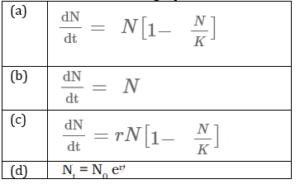
Q92. In the equation dN/dt, r represents:
(a) Population density at time
(b) Intrinsic rate of natural increase
(c) the base of natural logarithms
(d) Carrying capacity
Q93. Which of the following is a characteristic of growth?
(a) Size of a population keeps on changing
(b) Size of a population depends on food availability, predation pressure and adverse weather
(c) The density of a population in a given habitat fluctuates
(d) All of the above
Q94. Which of the following is an example of population?
(a) Cormorants in a wetland
(b) Teakwood trees in a forest tract
(c) Bacteria in a culture plate
(d) All of the above
Q95. If in a pond there were 50 lotus plants last year and through reproduction 10 new plants are added, taking the current population to 60, then what would be the birth rate?
(a) 0.02
(b) 0.1
(c) 0.2
(d) 0.5
Direction for the question 96 to 100: Read the passage and answer the question:
Sutton and Boveri argued that the pairing and separation of a pair of chromosomes would lead to the segregation of a pair of factors they carried. Sutton united the knowledge of chromosomal segregation with Mendelian principles and called it the chromosomal theory of inheritance. Following this synthesis of ideas, experimental verification of the chromosomal theory of inheritance by Thomas Hunt Morgan and his colleagues, led to discovering the basis for the variation that sexual reproduction produced. Morgan worked with the tiny fruit flies, Drosophila melanogaster which were found very suitable for such studies.
Q96. Why was Drosophila melanogaster found very suitable for studies made by Morgan?
(a) They showed a clear differentiation of the sexes
(b) Their single mating could produce a large number of progeny flies
(c) They complete their life cycle in about two weeks
(d) All of the above
Q97. Morgan hybridised yellow-bodied, white-eyed females to brown-bodied, red-eyed males and intercrossed their F1 progeny. He observed that
(1) Two genes did not segregate independently of each other
(2) Two genes segregated independently of each other
(3) The F2 ratio deviated very significantly from the 9:3:3:1 ratio
(4) The F2 ratio deviated very significantly from the 1:2:1 ratio
Choose the correct answer from the options given below:
(a) (1) and (2)
(b) (2) and (4)
(c) (3) and (4)
(d) (1) and (3)
Q98. Morgan and his group found that even when genes were grouped on the same chromosome, some genes were very tightly linked, such genes show
(a) Very high recombination
(b) Very low recombination
(c) Intermediate recombination
(d) No recombination
Q99. Which of the following is correct about recombination?
(a) These are non-parental gene combinations
(b) These are parental gene combinations
(c) It is physical association of genes
(d) Nothing can be said
Q100. Who of the following used the frequency of recombination between gene pairs on the same chromosome as a measure of the distance between genes and ‘mapped’ their position on the chromosome?
(a) Morgan
(b) Alfred Sturtevant
(c) Correns
(d) von Tschermak
Solutions
S1. Ans. (b)
Sol. Water hyacinth (Eichhornia crassipes) is called the ‘Terror of Bengal’. It is an exotic species which is not native to Bengal. But once it got introduced into the water bodies of Bengal, it grew very fast and competed with the native species eliminating many of them. It depleted the dissolved oxygen in the water bodies leading to large scale loss of aquatic life, particularly fishes. This is why water hyacinth is referred to as the ‘terror of Bengal’
S2. (b) Strobilanthus kunthiana or neelakuranji flowers in mass and turns it surrounding area into blue stretches.
S3.Ans.(d)
Sol. In non-primate mammals like cows, sheep, rats, deers, dogs, tiger, etc. the cyclical changes during reproduction are called oestrus cycle where as in primates (monkeys, apes, and humans) it is called menstrual cycle.
S4.Ans.(c)
Sol. When fruit develops without fertilization then the phenomenon is called as parthenocarpy. Such fruits have longer shelf life.
S5.Ans.(a)
Sol. The other male gamete moves towards the two polar nuclei and fuses with them to produce a triploid primary endosperm nucleus (PEN). As this involves the fusion of three haploid nuclei it is termed triple fusion.
S6. (d) plants have developed many mechanisms to prevent autogamy.
S7.Ans.(c)
Sol. The process of formation of a mature female gamete is called oogenesis. Oogenesis is initiated during the embryonic development stage when a couple of million gamete mother cells (oogonia) are formed within each fetal ovary; no more oogonia are formed and added after birth. These cells start division and enter into prophase-I of the meiotic division and get temporarily arrested at that stage, called primary oocytes.
S8.Ans.(d)
Sol. It is the endometrium that undergoes cyclical changes during menstrual cycle.
S9.Ans.(b)
Sol. In the later phase of pregnancy, a hormone called relaxin is also secreted by the ovary.
S10. (c) after spermiogenesis, the sperm becomes embedded in the Sertoli cells so that they get finally released from the seminifereneous tubules by the process of spermiation.
S11.Ans.(a)
Sol. Oral administration of small doses of either progestogens or progestogen–estrogen combinations is another contraceptive method used by the females. They are used in the form of tablets and hence are popularly called the pills.
S12. Ans. (b)
Sol. intrauterine devices are a safe, effective and popular method that is generally adopted by doctors and expert nurses.
S13. Ans. (b)
Sol. the disease is caused due to defect in either red or green cone of eye resulting in failure to discriminate between red and green colour.
S14.Ans.(b)
Sol. The inheritance of flower colour in the dog flower (snapdragon or Antirrhinum sp.) is a good example of incomplete dominance.
S15.Ans.(b)
Sol. The haemophilia is a sex-linked recessive disease which shows its transmission from an unaffected female carrier to some of the male progeny. In this disease, a single protein that is a part of the cascade of proteins involved in the coagulation of blood is affected. As a result of this, in an infected individual, a simple cut will result in non-stop bleeding. The heterozygous female carrier for haemophilia may transfer the disease to sons. The probability of the female becoming haemophilic is very rare because the mother of such a female has to be at least a carrier while the father should be haemophilic. It is an inherited genetic disorder which results in the deterioration of the formation of a blood clot. In a condition, where the father is normal and the mother is the carrier of haemophilia disease, then the female offspring that are produced may be normal or the carrier of the disease.
S16.Ans.(c)
Sol. The tRNA molecules are called as adaptor molecules because they can bind with both the amino acids as well as RNA.
S17. Ans. (b)
Sol. the gene y codes for permease which increases the permeability of the cell to beta galactosidase all the 3 gene products in Lac Operon are required for metabolism of lactose.
S18.Ans.(c)
Sol. the flow of genetic information from DNA to RNA to form a functional protein is the central dogma of molecular biology.
S19.Ans.(d)
Sol. The blood group “O” is considered the universal donor because it contains both the anti-A and anti-B antibodies and does not have any antigen.
S20.Ans.(d)
Sol. S.L. Miller supported Oprain and Haldan’s proposal. He created Earth’s reducing atmosphere during early days of development. He created electric discharge in a closed flask containing methane, hydrogen, ammonia and water vapour at 8000C. This resulted is the formation of amino acids. His experiment supported that the chemical evolution of organic molecules occurred from the inorganic substances.
S21.Ans.(d)
Sol. The Neanderthal man with a brain size of 1400cc lived in near east and central Asia between 1,00,000-40,000 years back. They used hides to protect their body and buried their dead.
S22.Ans.(d)
Sol. analogous structures are a result of convergent evolution – different structures evolving for the same function and hence having similarity. Other examples of analogy are the eye of the octopus and of mammals or the flippers of Penguins and Dolphins. Sweet potato (root modification) and potato (stem modification) is another example for analogy.
S23.Ans.(d)
Sol. Structures with similar anatomy, morphology, embryology and genetics but dissimilar functions are known as homologous structures. Structures that are superficially similar but anatomical dissimilar doing the same function are known as analogous structures
S24.Ans.(c)
Sol. Many fungi belonging to the genera Microsporum, Trichophyton and Epidermophyton are responsible for ringworms which is one of the most common infectious diseases in man
S25.Ans.(c)
Sol. Haemophilus influenzae is responsible for the disease pneumonia in humans which infects the alveoli (air filled sacs) of the lungs. As a result of the infection, the alveoli get filled with fluid leading to severe problems in respiration. The symptoms of pneumonia include fever, chills, cough and headache. In severe cases, the lips and fingernails may turn gray to bluish in colour.
S26. Ans. (d)
Sol. Sonalika and Kalyan Sona are high yielding wheat varieties that were introduced in 1963.
S27.Ans.(b)
Sol. Saccharum barberi was originally grown in north India, but had poor sugar content and yield.
S28. Ans. (b)
Sol. Protoplasts are cells which have had their cell wall removed, usually by digestion with enzymes.
S29.Ans.(c)
Sol. in cross-breeding superior males of one breed are mated with superior females of another breed, the progeny hybrid animals made themselves be used for the commercial purpose, they may be subjected to some form of inbreeding and selection process to develop new stable breed that may be superior to the existing breed.
S30.Ans.(c)
Sol. Natural manures, compost, and bio-fertilizers are used in organic farming by farmers.
S31.Ans.(a)
Sol. cyclosporin A, is used as an immunosuppressive agent in organ-transplant patients, it is produced by the fungus Trichoderma polysporum.
S32.Ans.(d)
Sol. The technology of biogas production was developed in India mainly due to the efforts of Indian Agricultural Research Institute (IARI) and Khadi and Village Industries Commission (KVIC).
S33. Ans. (b)
Sol. Swiss cheese is produced by bacterium Propionibacterium sharmanii. It has large holes in it.
S34. (c) Hind II was the first restriction endonuclease to be discovered and it always cuts DNA molecules a particular point by recognising 6 place face sequence.
S35.Ans.(c)
Sol. Exonucleases are the enzymes that cut the double stranded or single stranded DNA and remove the nucleotides from the 5’ or 3’ ends.
S36.Ans.(c)
Sol. In a method known as micro-injection, recombinant DNA is directly injected into the nucleus of an animal cell. In another method, suitable for plants, cells are bombarded with high velocity micro-particles of gold or tungsten coated with DNA in a method known as biolistics or gene gun.
S37.Ans.(c)
Sol. Today transgenic models exist for many human diseases such as cancer, cystic fibrosis, rheumatoid arthritis and Alzheimer’s.
S38. Ans. (d)
Sol. the Bt toxins are very insect specific, cry1Ab controls corn borers while cryIAc and cryIIAb controls cotton ball worms
S39. Ans. (b)
Sol. any species growing exponentially under unlimited resource condition can reach enormous population densities in a short time and the graph obtained will be J-shaped.
S40.Ans.(a)
Sol. The death rate of that interval would be 400/1000 = 0.4
S41.Ans.(c)
Sol. Secondary succession begins in areas where natural biotic communities have been destroyed such as in abandoned farm lands, burned or cut forests, lands that have been flooded.
S42.Ans.(d)
Sol. In a particular climatic condition, decomposition rate is slower if detritus is rich in lignin and chitin, and quicker, if detritus is rich in nitrogen and water-soluble substances like sugars.
S43.Ans.(c)
Sol. nutrients are never lost from the ecosystems, are recycled time and again indefinitely. The movement of nutrient elements through the various components of an ecosystem is called nutrient cycling. Another name of nutrient cycling is biogeochemical cycle.
S44.Ans.(a)
Sol. During his pioneering and extensive explorations in the wilderness of South American jungles, the great German naturalist and geographer Alexander von Humboldt observed that within a region species richness increased with increasing explored area, but only up to a limit.
S45. Ans. (d)
Sol. the zoological parks, botanical gardens and wildlife safari park are a method of ex-situ conservation in which threatened animals and plants are taken out from the natural habitat and placed in special setting where they can be protected and given special care.
S46.Ans.(b)
Sol. The narrowly utilitarian arguments for conserving biodiversity are obvious; humans derive countless direct economic benefits from nature food (cereals, pulses, fruits), firewood, fibre, construction material, industrial products (tannins, lubricants, dyes, resins, perfumes ) and products of medicinal importance. The broadly utilitarian argument says that biodiversity plays a major role in many ecosystem services that nature provides. The fast dwindling Amazon forest is estimated to produce, through photosynthesis, 20 per cent of the total oxygen in the earth’s atmosphere. Pollination (without which plants cannot give us fruits or seeds) is another service, ecosystems provide through pollinators layer – bees, bumblebees, birds and bats.
S47.Ans.(c)
Sol. According to Central Pollution Control Board (CPCB), particulate size 2.5 micrometers or less in diameter (PM 2.5) are responsible for causing the greatest harm to human health.
S48. Ans. (b)
Sol. Catalytic converters, having expensive metals namely platinum-palladium and rhodium as the catalysts, are fitted into automobiles for reducing emission of poisonous gases.
S49. Ans. (c)
Sol. 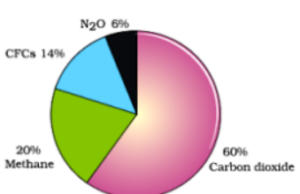
S50. Ans. (c)
Sol. Alfred Hershey and Martha Chase worked with viruses that infect bacteria called bacteriophages.
S51. Ans. (b)
Sol. Common cold is caused due to droplets resulting from Nasal congestion and VIRUSES cough or sneezes of an discharge, sore throat, infected person are either hoarseness, cough, headache, inhaled directly or tiredness, etc. which lasts for transmitted through 3-7 days contaminated objects such as pens, books, cups, door knobs, etc. Dysentery, plague, diphtheria, etc., are some of the other bacterial diseases in man.
S52. (b) The construction of first recombinant DNA emerged from the linking of the gene encoding antibiotic resistance gene with a native plasmid of Salmonella typhimurium.It was accomplished by Stanley Cohen and Herbert Boyer in 1972. They isolated the antibiotic resistance gene by cutting out a piece of DNA. This cutting of DNA at specific locations is carried out by molecular scissors also known as restriction enzymes. The ori site or origin of the replication site is a specific nucleotide sequence on the vector DNA that initiates replication. Any piece of DNA when linked to this sequence can be made to replicate within the host cells.
S53.Ans.(c)
Sol. To improve chances of successful production of hybrids, other means are also used. Multiple Ovulation Embryo Transfer Technology (MOET) is one such programme for herd improvement. In this method, a cow is administered hormones, with FSH-like activity, to induce follicular maturation and super ovulation – instead of one egg, which they normally yield per cycle, they produce 6-8 eggs.
S54.Ans (a)
Sol. The pyramid of biomass represents the total biomass generated and transferred at different consecutive trophic levels per unit area of an ecosystem. The pyramid of biomass is always upright according to the amount of biomass. In tree ecosystem, the shape of pyramid of biomass is always upright. In this, the biomass is maximum at producer level, followed by primary consumer level (herbivores), followed by secondary consumer level (carnivores).
S55.Ans.(c)
Sol. When a species becomes extinct, the plant and animal species associated with it in an obligatory way also become extinct. When a host fish species becomes extinct, its unique assemblage of parasites also meets the same fate. Steller’s sea cow and passenger pigeon got extinct due to over-exploitation.
S56.Ans.(b)
Sol. The offspring formed by asexual reproduction are identical and can be referred to as clones. Ginger vegetatively propagates by rhizome.
S57.Ans.(b)
Sol. Lactose is the substrate for the enzyme beta-galactosidase and it regulates switching on and off of the operon. Hence, it is termed as inducer. In the absence of a preferred carbon source such as glucose, if lactose is provided in the growth medium of the bacteria, the lactose is transported into the cells through the action of permease. In the presence of an inducer, such as lactose or allolactose, the repressor is inactivated by interaction with the inducer. This allows RNA polymerase access to the promoter and transcription proceeds.
S58.Ans.(a)
Sol. The average duration of human pregnancy is about 9 months. The blastomeres in the blastocyst are arranged into an outer layer called trophoblast and an inner group of cells attached to trophoblast called the inner cell mass.
S59.Ans.(d)
Sol. there are a few species in which fruits develop without fertilisation. Such fruits are called parthenocarpic fruits. Banana is one such example. Parthenocarpy can be induced through the application of growth hormones and such fruits are seedless.
S60.Ans.(d)
Sol. DNA is a long polymer of deoxyribonucleotides. The backbone of a polynucleotide chain is formed due to sugar and phosphates. The two chains are coiled in a right-handed fashion.
S61.Ans.(a)
Sol. Primary treatment steps basically involve physical removal of particles – large and small – from the sewage through filtration and sedimentation. The primary effluent is passed into large aeration tanks where it is constantly agitated mechanically and air is pumped into it. This allows vigorous growth of useful aerobic microbes into flocs. Once the BOD of sewage or waste water is reduced significantly, the effluent is then passed into a settling tank where the bacterial ‘flocs’ are allowed to sediment. d into a settling tank where the bacterial ‘flocs’ are allowed to sediment. This sediment is called activated sludge. A small part of the activated sludge is pumped back into the aeration tank to serve as the inoculum. The remaining major part of the sludge is pumped into large tanks called anaerobic sludge digesters. Here, other kinds of bacteria, which grow anaerobically, digest the bacteria and the fungi in the sludge. The effluent from the secondary treatment plant is generally released into natural water bodies like rivers and streams.
S62.Ans.(d)
Sol. national parks and wildlife sanctuaries is an in-situ approach while cryopreservation technique is an ex-situ approach.
S63.Ans.(d)
Sol. 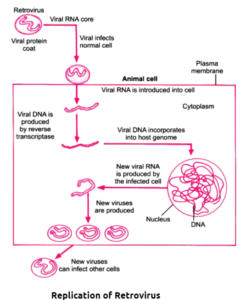
S64.Ans.(d)
Sol. The yeast Saccharomyces cerevisiae used for bread-making and commonly called brewer’s yeast, is used for fermenting malted cereals and fruit juices, to produce ethanol. Wine and beer are produced without distillation whereas whisky, brandy and rum are produced by distillation of the fermented broth.
S65.Ans.(d)
Sol. Saheli–the new oral contraceptive for the females contains a non-steroidal preparation. It is a ‘once a week’ pill with very few side effects and high contraceptive value. It was developed by scientists at Central Drug Research Institute (CDRI) in Lucknow, India.
S66.Ans.(a)
Sol. Embryological support for evolution was also proposed by Ernst Heckel based upon the observation of certain features during embryonic stage common to all vertebrates that are absent in adult. However, this proposal was disapproved on careful study performed by Karl Ernst von Baer.
S67. Ans. (b)
Sol. The size of a population for any species is not a static parameter. It keeps changing with time, depending on various factors including food availability, predation pressure and adverse weather. Emigration is the number of individuals of the population who left the habitat and gone elsewhere during the time period under consideration
S68.Ans.(a)
Sol. Gene therapy is a collection of methods that allows correction of a gene defect that has been diagnosed in a child/embryo. Here genes are inserted into a person’s cells and tissues to treat a disease. Correction of a genetic defect involves delivery of a normal gene into the individual or embryo to take over the function of and compensate for the non-functional gene. The first clinical gene therapy was given in 1990 to a 4-year old girl with adenosine deaminase (ADA) deficiency.
S69.Ans.(a)
Sol. During pregnancy all events of the menstrual cycle stop and there is no menstruation. In the
absence of fertilisation, the corpus luteum degenerates. This causes disintegration of the
endometrium leading to menstruation, marking a new cycle. Rapid secretion of LH leading to its
maximum level during the mid-cycle called LH surge induces rupture of Graafian follicle and thereby
the release of ovum (ovulation).
S70. Ans. (c)
Sol. Down’s Syndrome is caused due to the presence of an additional copy of the chromosome number 21 (trisomy of 21). This disorder was first described by Langdon Down (1866). The affected individual is short statured with small round head, furrowed tongue and partially open mouth.
S71.Ans.(c)
Sol. Francis Crick proposed the Central dogma in molecular biology, which states that the genetic information flows from DNA to RNA and RNA to protein. The technique of DNA Fingerprinting was initially developed by Alec Jeffreys. The elucidation of the lac operon was also a result of a close association between a geneticist, Francois Jacob and a biochemist, Jacque Monod. George Gamow was a physicist who stated the fact that codons are triplet in nature.
S72. (b) Leaf buds are found in Bryophyllum, bulbils in Agave, eyes in potato and offset in water hyacinth.
S73.Ans.(b)
Sol. In vasectomy, vas deferens is cut thus semen contains no sperms, condom prevents sperms from reaching the cervix, and pills prevent ovulation.
S74.Ans.(b)
Sol. whales, bats, Cheetah and human (all mammals) share similarities in the pattern of bones of forelimbs. Though these forelimbs perform different functions in these animals, they have similar anatomical structure. This is divergent evolution and these structures are homologous. Wings of butterfly and of birds look alike. They are not anatomically similar structures though they perform similar functions. Hence, analogous structures are a result of convergent evolution. Another interesting observation supporting evolution by natural selection is industrial melanism. Australian marsupials is an example of adaptive radiation.
S75.Ans.(d)
Sol. Lipases are used in detergent formulations and are helpful in removing oily stains from the laundry. Streptokinase produced by the bacterium Streptococcus and modified by genetic engineering is used as a ‘clot buster’ for removing clots from the blood vessels of patients who have undergone myocardial infarction leading to heart attack. Another bioactive molecule, cyclosporin A, that is used as an immunosuppressive agent in organ-transplant patients, is produced by the fungus Trichoderma polysporum. Statins produced by the yeast Monascus purpureus have been commercialised as blood-cholesterol lowering agents.
S76. (b) The ovule is a small structure attached to the placenta by means of a stalk called funicle. The body of the ovule fuses with funicle in the region called hilum. Thus, hilum represents the junction between ovule and funicle. Each ovule has one or two protective envelopes called integuments. Integuments encircle the nucellus except at the tip where a small opening called the micropyle is organised. Opposite the micropylar end, is the chalaza, representing the basal part of the ovule.
S77.Ans.(d)
Sol. Placenta also acts as an endocrine tissue and produces several hormones like human chorionic gonadotropin (hCG), human placental lactogen (hPL), estrogens, progestogens, etc. In the later phase of pregnancy, a hormone called relaxin is also secreted by the ovary. The corpus luteum secretes large amounts of progesterone which is essential for maintenance of the endometrium.
S78. Ans. (c)
Sol. Plasmodium enters the human body as sporozoites (infectious form) through the bite of infected female Anopheles mosquito. Entamoeba histolytica is a protozoan parasite in the large intestine of human which causes amoebiasis (amoebic dysentery). Wuchereria (W. bancrofti and W. malayi), the filarial worms cause a slowly developing chronic inflammation of the organs in which they live for many years, usually the lymphatic vessels of the lower limbs and the disease is called elephantiasis or filariasis.
S79.Ans.(b)
Sol. Detritivores (e.g., earthworm) break down detritus into smaller particles. This process is called fragmentation. By the process of leaching, watersoluble inorganic nutrients go down into the soil horizon and get precipitated as unavailable salts. Bacterial and fungal enzymes degrade detritus into simpler inorganic substances. This process is called as catabolism. The humus is further degraded by some microbes and release of inorganic nutrients occur by the process known as mineralisation.
S80.Ans.(d)
Sol. In bacteria, there are three major types of RNAs: mRNA (messenger RNA), tRNA (transfer RNA), and rRNA (ribosomal RNA). All three RNAs are needed to synthesise a protein in a cell. The mRNA provides the template, tRNA brings aminoacids and reads the genetic code, and rRNAs play structural and catalytic role during translation.
S81.Ans.(a)
Sol. In 1997, an American company got patent rights on Basmati rice through the US Patent and Trademark Office. This allowed the company to sell a ‘new’ variety of Basmati, in the US and abroad. This ‘new’ variety of Basmati had actually been derived from Indian farmer’s varieties. Indian Basmati was crossed with semi-dwarf varieties and claimed as an invention or a novelty.
S82.Ans.(c)
Sol. Biopiracy is the term used to refer to the use of bio-resources by multinational companies and other organisations without proper authorisation from the countries and people concerned without compensatory payment.
S83.Ans.(a)
Sol. There are an estimated 200,000 varieties of rice in India alone. The diversity of rice in India is one of the richest in the world.
S84.Ans.(b)
Sol. Most of the industrialised nations are rich financially but poor in biodiversity and traditional knowledge. In contrast the developing and the underdeveloped world is rich in biodiversity and traditional knowledge related to bio-resources. Traditional knowledge related to bio-resources can be exploited to develop modern applications and can also be used to save time, effort and expenditure during their commercialisation. There has been growing realisation of the injustice, inadequate compensation and benefit sharing between developed and developing countries. Therefore, some nations are developing laws to prevent such unauthorised exploitation of their bio-resources and traditional knowledge.
S85.Ans.(b)
Sol. The Indian Parliament has recently cleared the second amendment of the Indian Patents Bill, that takes such issues into consideration, including patent terms emergency provisions and research and development initiative.
S86. Ans. (c)
Sol. The yellowish fluid colostrum secreted by mother during the initial days of lactation has abundant antibodies (IgA) to protect the infant. The foetus also receives some antibodies from their mother, through the placenta during pregnancy. These are some examples of passive immunity.
S87. Ans. (a)
Sol. The antibodies produced during allergy of IgE type.
S88. Ans. (b)
Sol. The principle of immunization or vaccination is based on the property of ‘memory’ of the immune system.
S89. Ans. (b)
Sol. In cases of snakebites, the injection which is given to the patients, contain preformed antibodies against the snake venom. This type of immunisation is called passive immunisation.
S90. Ans. (d)
Sol. The use of drugs like anti-histamine, adrenalin and steroids quickly reduce the symptoms of allergy.
S91. Ans. (c)
Sol. A population growing in a habitat with limited resources show initially a lag phase, followed by phases of acceleration and deceleration and finally an asymptote, when the population density reaches the carrying capacity. A plot of N in relation to time (t) results in a sigmoid curve. This type of population growth is called Verhulst-Pearl Logistic Growth and is described by the following equation:
S92. Ans. (b)
Sol. The r in the above equation is called the ‘intrinsic rate of natural increase’ and is a very important parameter chosen for assessing impacts of any biotic or abiotic factor on population growth.
S93. Ans. (d)
Sol. The size of a population for any species is not a static parameter. It keeps changing with time, depending on various factors including food availability, predation pressure and adverse weather. In fact, it is these changes in population density that give us some idea of what is happening to the population – whether it is flourishing or declining. Whatever might be the ultimate reasons, the density of a population in a given habitat during a given period, fluctuates due to changes in four basic processes natality, mortality, emigration and immigration.
S94. Ans. (d)
Sol. In nature, we rarely find isolated, single individuals of any species; majority of them live in groups in a well defined geographical area, share or compete for similar resources, potentially interbreed and thus constitute a population. Although the term interbreeding implies sexual reproduction a group of individuals resulting from even asexual reproduction is also generally considered a population for the purpose of ecological studies. All the cormorants in a wetland, rats in an abandoned dwelling, teakwood trees in a forest tract, bacteria in a culture plate and lotus plants in a pond, are some examples of a population.
S95. Ans. (c)
Sol. birth rate as 10/50 = 0.2, birth rate is 0.2
S96.Ans.(d)
Sol. Drosophila melanogaster were found very suitable for studies made by Morgan because they could be grown on simple synthetic medium in the laboratory. They complete their life cycle in about two weeks, and a single mating could produce a large number of progeny flies. Also, there was a clear differentiation of the sexes – the male and female flies are easily distinguishable. Also, it has many types of hereditary variations that can be seen with low power microscopes.
S97.Ans.(d)
Sol. Morgan carried out several dihybrid crosses in Drosophila to study genes that were sex-linked. The crosses were similar to the dihybrid crosses carried out by Mendel in peas. For example Morgan hybridised yellow-bodied, white-eyed females to brown-bodied, red-eyed males and intercrossed their F1 progeny. He observed that the two genes did not segregate independently of each other and the F2 ratio deviated very significantly from the 9:3:3:1 ratio.
S98.Ans.(b)
Sol. Morgan and his group also found that even when genes were grouped on the same chromosome, some genes were very tightly linked (showed very low recombination) while others were loosely linked (showed higher recombination).
S99.Ans.(a)
Sol. Recombination are non-parental gene combinations.
S100.Ans.(b)
Sol. Alfred Sturtevant used the frequency of recombination between gene pairs on the same chromosome as a measure of the distance between genes and ‘mapped’ their position on the chromosome. Today genetic maps are extensively used as a starting point in the sequencing of whole genomes as was done in the case of the Human Genome Sequencing Project.
CUET UG Biology Important Questions and Answers PDF
Download the CUET UG Biology important questions and answers PDF below.

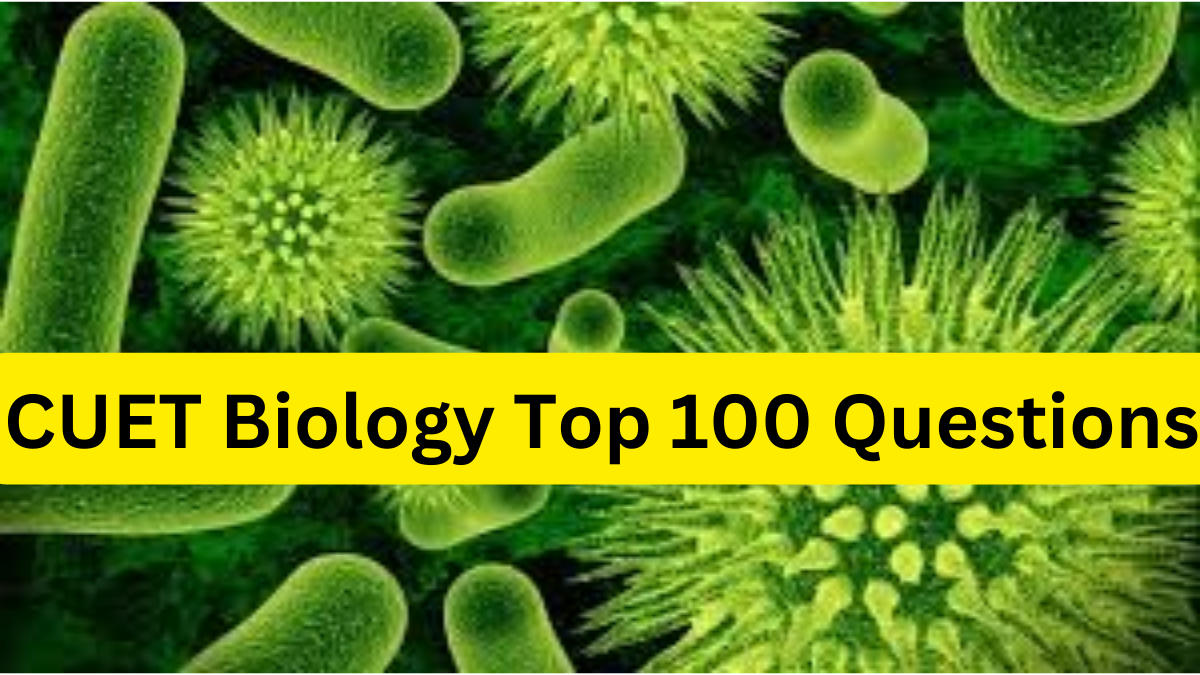
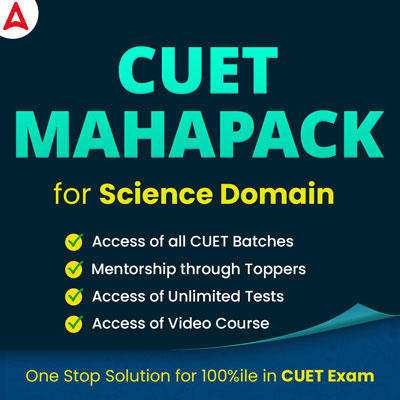

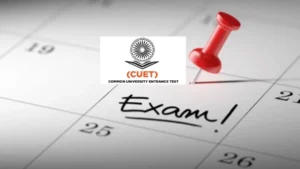 CUET UG Exam Date Sheet 2025 @cuet.nta.n...
CUET UG Exam Date Sheet 2025 @cuet.nta.n...
 CUET Accountancy Chapter Wise Weightage ...
CUET Accountancy Chapter Wise Weightage ...
 CUET English Question Paper (2024, 2023)...
CUET English Question Paper (2024, 2023)...
